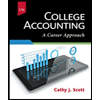
Prepare journal entries to record the given transactions and events.
Explanation of Solution
Depreciation expense is a non-cash expense, which is recorded on the income statement reflecting the consumption of economic benefits of long-term asset on account of its wear and tear or obsolescence.
Prepare
| Date | Account Title and Explanation |
Debit ($) |
Credit ($) |
| January 1, Year 1 | Equipment (1) | 300,600 | |
| Cash | 300,600 | ||
| (To record the costs of loader) |
Table (1)
Working Note:
Calculate the costs of loader.
- Equipment is an asset account and it is increased. Therefore debit equipment account.
- Cash is an asset account and it is decreased. Therefore credit cash account.
Prepare journal entry to record the betterment of the loader as follows:
| Date | Account Title and Explanation |
Debit ($) |
Credit ($) |
| January 3, Year 1 | Equipment | 4,800 | |
| Cash | 4,800 | ||
| (To record the betterment of loader) |
Table (2)
- Equipment is an asset account and it is increased. Therefore debit equipment account.
- Cash is an asset account and it is decreased. Therefore credit cash account.
Prepare journal entry to record the depreciation expense as follows:
| Date | Account title and Explanation | Post Ref. |
Debit ($) |
Credit ($) |
| December 31, Year 1 | Depreciation expense (3) | 70,850 | ||
| | 70,850 | |||
| (To record the depreciation expense) |
Table (3)
Working Note:
Calculate the depreciable cost:
| Amount ($) | |
| Total original cost | 300,600 |
| Add: Cost of betterment | 4,800 |
| Revised cost of equipment | 305,400 |
| Less: Revised salvage | 22,000 |
| Depreciable Cost | $283,400 |
Table (4)
…… (2)
Calculate the depreciation expense (for year 1) after January 3rd betterment:
- Depreciation expense is a component of
stockholder’s equity. It decreases the stockholder’s equity. Thus, depreciation expense is debited. - Accumulated depreciation is a contra asset which decreases the value of the asset. Increase in accumulated depreciation decreases the asset’s value. Thus, accumulated depreciation on equipment is credited.
Prepare journal entry to record the extraordinary repair on loader as follows:
| Date | Account Title and Explanation |
Debit ($) |
Credit ($) |
| January 1, Year 2 | Equipment | 5,400 | |
| Cash | 5,400 | ||
| (To record the extraordinary repair on loader) |
Table (5)
- Equipment is an asset account and it is increased. Therefore debit equipment account.
- Cash is an asset account and it is decreased. Therefore credit cash account.
Prepare journal entry to record the ordinary repair on the loader as follows:
| Date | Account Title and Explanation |
Debit ($) |
Credit ($) |
| February 17, Year 2 | Repairs expense–Equipment | 820 | |
| Cash | 820 | ||
| (To record the betterment of loader) |
Table (6)
- Repairs expenses are the components of the stockholder’s equity. An expense decreases the stockholder’s equity. Thus, repairs expenses account is debited.
- Cash is an asset account, and it is decreased. Thus, credit the cash account.
Prepare journal entry to record the depreciation expense as follows:
| Date | Account title and Explanation | Post Ref. |
Debit ($) |
Credit ($) |
| December 31, Year 2 | Depreciation expense (4) | 43,590 | ||
| Accumulated depreciation | 43,590 | |||
| (To record the depreciation expense) |
Table (7)
Working Note:
Calculate the depreciable cost.
| Amount ($) | |
| Total original cost | 310,800 |
| Less: Accumulated depreciation | 70,850 |
| Book value | 239,950 |
| Less: Salvage | 22,000 |
| Depreciable Cost | $217,950 |
Table (8)
…… (3)
Calculate the depreciation expense for the year 2 after January 1st extraordinary repair.
- Depreciation expense is a component of stockholder’s equity. It decreases the stockholder’s equity. Thus, depreciation expense is debited.
- Accumulated depreciation is a contra asset which decreases the value of the asset. Increase in accumulated depreciation decreases the asset’s value. Thus, accumulated depreciation on equipment is credited.
Want to see more full solutions like this?
Chapter 10 Solutions
Principles of Financial Accounting.
- Please provide the solution to this general accounting question with accurate financial calculations.arrow_forwardI need help solving this general accounting question with the proper methodology.arrow_forwardCan you help me solve this general accounting problem using the correct accounting process?arrow_forward
- Principles of Accounting Volume 1AccountingISBN:9781947172685Author:OpenStaxPublisher:OpenStax College
 Managerial AccountingAccountingISBN:9781337912020Author:Carl Warren, Ph.d. Cma William B. TaylerPublisher:South-Western College Pub
Managerial AccountingAccountingISBN:9781337912020Author:Carl Warren, Ph.d. Cma William B. TaylerPublisher:South-Western College Pub - Century 21 Accounting Multicolumn JournalAccountingISBN:9781337679503Author:GilbertsonPublisher:Cengage
 College Accounting (Book Only): A Career ApproachAccountingISBN:9781337280570Author:Scott, Cathy J.Publisher:South-Western College Pub
College Accounting (Book Only): A Career ApproachAccountingISBN:9781337280570Author:Scott, Cathy J.Publisher:South-Western College Pub





